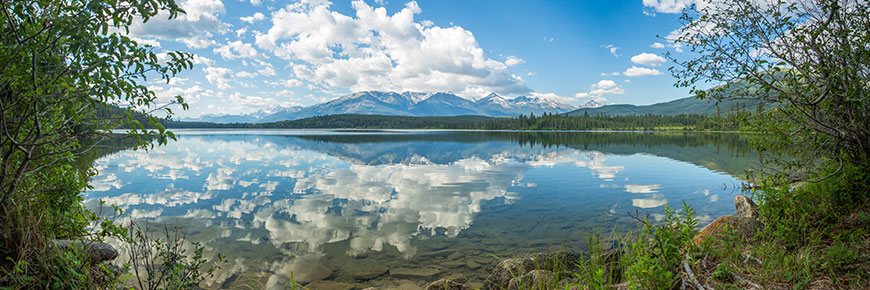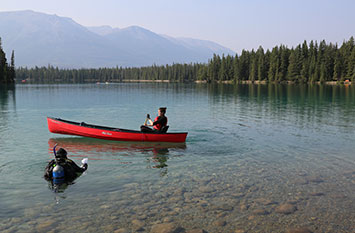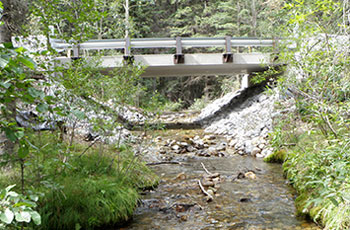
Jasper National Park Shoreline Action Plan
Jasper National Park
Improving ecological integrity and visitor experience at lakes and rivers in Jasper National Park
Purpose
To restore and protect lakes and rivers and their shoreline habitats in Jasper National Park to improve ecological integrity and enhance visitor experience.
Background
Jasper National Park’s many lakes harbour diverse ecological communities and represent one of the premiere visitor attractions to the park both for their scenic beauty and the recreational opportunities they afford. Healthy lake ecosystems include healthy riparian habitat that is important for nesting waterfowl, beavers, amphibians, and countless plant and insect species. Those same shorelines also attract large numbers of park visitors recreating on or near the water, enjoying the spectacular views and the opportunities to see a variety of wildlife.
Invasive aquatic species such as whirling disease, quagga mussels, and zebra mussels pose emerging threats to aquatic ecosystems generally. Parks Canada is committed to protecting these lakes and shorelines to ensure they maintain their significant ecological role as well as to provide visitors with experiences consistent with Jasper’s World Heritage status.
The Athabasca River in Jasper National Park is also designated a Canadian Heritage River for its many celebrated natural, cultural, and recreational features. Protection of shorelines is priority for Parks Canada.
A number of stressors are affecting park lake and river shorelines. Collectively, they represent a cumulative and growing impact to ecological integrity and visitor experience, which Parks Canada would like to prevent or mitigate.
Approach
Parks Canada will follow a three-pronged approach which touches on all aspects of Parks Canada’s mandate to implement actions that will improve riparian zones as recommended in the Jasper Park Management Plan and the Maligne Valley Action Plan:
I. Clean up - riparian areas
II. Protect - aquatic wildlife and park visitors at Jasper’s lakes
III. Restore – aquatic ecosystems
Components of Jasper National Park Shoreline Action Plan
Clean up riparian areas
- Garbage on shorelines
Litter and other garbage collects on many water bodies along transportation routes and areas of significant infrastructure development. Garbage is unsightly, takes away from visitor experience, and can present a risk to wildlife species.
Goal: Lake and river shorelines are free of litter and other garbage.
Objective: Engage volunteer groups to clean up a priority list of Jasper National Park Great Canadian Shoreline Cleanup (GCSC) sites annually.
- Unauthorized storage of personal watercraft along shorelines
Unauthorized storage of personal boats on park shorelines continues to increase. Otherwise scenic and accessible shorelines are becoming eyesores, cluttered with private and abandoned boats, often in very poor condition, that have been left by unknown people for unknown periods of time. Unsecured watercraft pose visitor safety and liability concerns. Storage of personal boats on park shorelines may also destroy and degrade shoreline vegetation.
Goal: Lakes and rivers are not used for storage of personal watercraft.
Objective: Personal watercraft are removed from lake and river shorelines by 2020.
- Storage of commercial watercraft along shorelines
Commercial outfitters that offer watercraft rental and fishing opportunities provide a valued service to visitors of the park. Both Parks Canada and outfitters want to ensure that commercial watercraft stored at lakes are in good repair, stowed in a safe manner, and do not compromise the area’s scenic beauty.
Goal: To ensure commercial outfitters provide a safe and enjoyable experience to visitors through the rental of canoes and other watercraft.
Objectives: To ensure commercial outfitters are complying with the numbers and locations of boats permitted in their existing licences and that boats are safe, in good repair, and stored in a manner that does not compromise scenic views.
Protect aquatic wildlife and park visitors
- Aquatic invasive species
Whirling disease, quagga mussels, and zebra mussels are three invasive species whose distributions are creeping closer to Jasper. All three can have devastating impacts to aquatic ecosystems. Transmission is generally through the movement of contaminated boats and boat trailers, aquatic recreational equipment, fishing gear, or contaminated fish from an infected watershed.
Goal: To prevent or minimize the establishment of aquatic invasive species in waterbodies in Jasper National Park.
Objective: In conjunction with regional provincial agencies and the other mountain parks field units, develop and implement a strategy to prevent the establishment of aquatic invasive species in Jasper National Park.
- Recreational fishing
Recreational fishing represents one of the few consumptive activities permitted in Jasper National Park and the most direct ecological impact to the park’s fish populations. Historically, it has been the rationale for extensive stocking of non-native species throughout the park which has resulted in significant change to aquatic ecological communities. Parks Canada continually evaluates and adjusts fishing regulations as new scientific information becomes available to ensure the protection of native species and species at risk.
Goal: Fishing regulations and closures promote the long-term survival of healthy populations of native fish species.
Objective: Review and revise fishing regulations in the context of the protection of native species and species at risk, with special consideration to minimizing the potential spread of aquatic invasive species.
- Electric boat motors
Historically, Jasper National Park has not prevented the use of electric motors. However, the use of motorized watercraft is prohibited by the Canada National Parks Act “except as permitted by a sign or notice placed, posted or erected by the superintendent at or near the watercourse”. As electric motor technology rapidly improves, the issue of electric motor use will become a more significant visitor experience and visitor safety issue, as well as a possible ecological risk to waterfowl such as loons nesting and raising chicks along the shoreline.
Goal: Ensure that Jasper National Park is effectively managing the emerging technology of electric motors to minimize negative impacts to visitor experience and ecological integrity.
Objective: Review where electric motors are currently used and the impacts or potential impacts they have on lake and river ecosystems and visitor experience.
Restore aquatic ecosystems
- Managing shoreline infrastructure to improve visitor experience and visitor safety, and restore riparian habitat
Providing infrastructure for visitors to enjoy Jasper’s many lakes requires that Parks Canada continually evaluate and improve the way we do business around water bodies to ensure that park facilities minimize ecological impacts and ensure visitor safety. Infrastructure such as boat launches and docks, for example, may be in need of repair or considered for possible removal in the context of aquatic invasive species. Infrastructure such as culverts at stream crossings along transportation corridors can significantly alter aquatic habitat and prevent stream continuity.
Non-park infrastructure may also be present, such as docks and rafts associated with cabins or businesses. There may be issues such as runoff or erosion around beaches, trails, day use areas, septic fields and commercial operations such as the golf course. There could be opportunities to enhance visitor experience while restoring degraded locations through actions such as the construction of boardwalks. It is also important to ensure that storm water management and wastewater treatment plants meet effluent targets.
Other infrastructure may have lost its utility, but still negatively impacts aquatic ecosystems.
Goal: Lake and river shorelines are free of infrastructure except where needed to enable visitor enjoyment and safety, or prevent ecosystem damage.
Objective 1: To ensure that authorized shoreline infrastructure meets visitor needs, is in good repair, and does not pose a risk to visitor safety or aquatic ecosystems.
Objective 2: To restore and maintain, to the highest degree practical, natural hydrology and riparian / wetland habitat and natural passage for fish and other aquatic species at road and rail stream crossings.
- Date modified :


